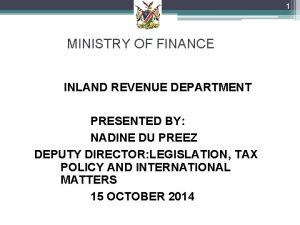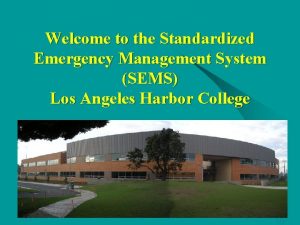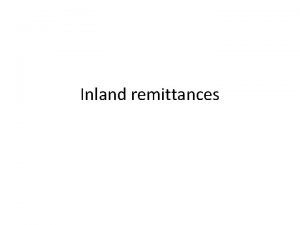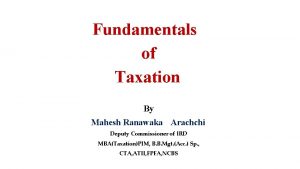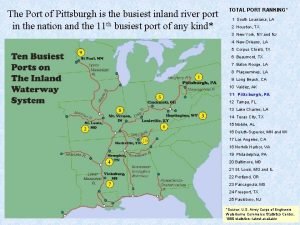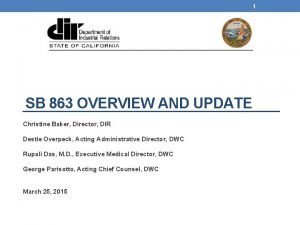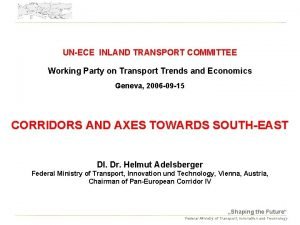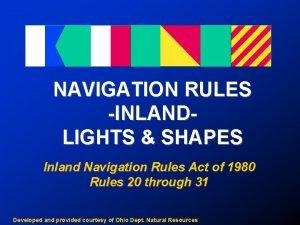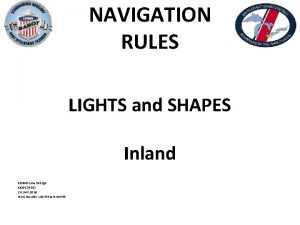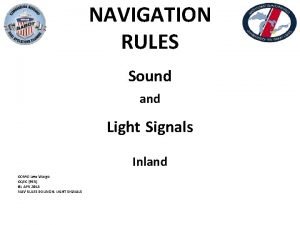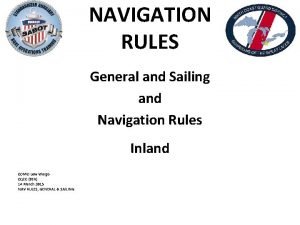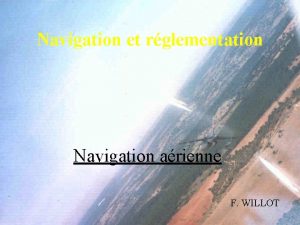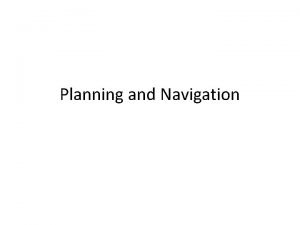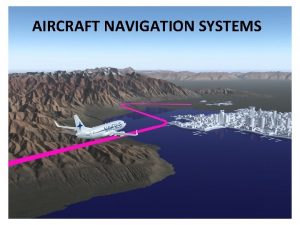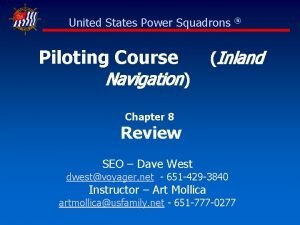NAVIGATION RULES INLANDRULES OF THE ROAD Inland Navigation















































- Slides: 47

NAVIGATION RULES -INLAND“RULES OF THE ROAD” Inland Navigation Rules Act of 1980 Rules 1 through 38 Developed and provided courtesy of Ohio Dept. Natural Resources

Disclaimer ! The Rules presented in this program are an overview of summarized versions of the Inland Navigation Rules. ! This program should not be considered a substitute for a complete version of the entire Inland Navigation Rules. ! The summarized rules in this program could be interpreted differently than the complete rules of the Inland Navigation Rules.

Application of Rules (Rules 1, 4, 11, 19 a) ! These Rules (1 -38) apply to all vessels upon the inland waters of the U. S. and to U. S. vessels on Canadian waters of the Great Lakes. # 1 -3 General Rules # 4 -19 Steering and Sailing Rules ! 4 -10 apply in any condition of visibility ! 11 -18 apply to vessels in sight of one another ! 19 apply to vessels in restricted visibility # 20 -31 Lights and Shapes # 32 -37 Sound and Light Signals # 38 Exemptions

Responsibility (Rule 2) ! Nothing in these rules shall exonerate any vessel, operator or owner from the consequences of: # neglect to comply with these rules # neglect of any required precaution # special circumstances of the case ! In complying with these rules due regard shall be had to all dangers of navigation and collision and to any special circumstances, including the limits of the vessels involved, which may make a departure from these rules necessary to avoid immediate danger.

General Definitions (Rule 3) ! Vessel - every description of watercraft capable of being used for transportation on the water ! Power-driven vessel - any vessel propelled by machinery. ! Sailing vessel - any vessel under sail provided any propelling machinery is not being used. ! Underway - not at anchor, made fast to shore or aground. ! Inland Waters – navigable waters of the U. S. shoreward of the demarcation lines dividing the high seas from harbors and other inland waters.

Important Terms ! These terms are defined in detail by Rules 16 and 17 ! Give-way - a term used for the vessel which is directed by rule to keep out of the way. ! Stand-on - a term used for the vessel which is directed by rule to keep its course and speed. # May take action if apparent other vessel is not taking appropriate action # Shall take action if necessary to avoid collision

Application of Rules (Rule 4) ! Rules in this part apply in any condition of visibility. # “This part” refers to Steering and Sailing Rules 4 -19

Proper Look-Out Required (Rule 5) ! Every vessel shall at all times maintain a proper look-out by sight and hearing as well as by all available means appropriate in the prevailing circumstances and conditions to make a full appraisal of the situation and of risk of collision.

Safe Speed (Rule 6) ! Every vessel shall proceed at a safe speed so that it can take proper and effective action to avoid collision and be stopped within a distance appropriate to the prevailing circumstances and conditions.

Safe Speed (Rule 6) ! In determining a safe speed the following factors shall be taken into account: # Visibility # Traffic density # Maneuverability including stopping distance and turning ability in the prevailing conditions # At night the presence of background light # Wind, sea, current, and proximity of hazards # Draft in relation to depth of water ! Additional factors for vessels with radar.

Risk of Collision (Rule 7) ! Every vessel shall use all available means appropriate to the prevailing circumstances and conditions to determine if risk of collision exists. If there is any doubt, such risk shall exist. ! Proper use shall be made of radar equipment if fitted and operational, to obtain early warning of risk of collision. ! Assumptions shall not be made.

Risk of Collision (Rule 7) RELATIVE BEARING (Angle to other vessels) DOES NOT CHANGE ! In determining if risk of collision exists: Such risk shall exist if the compass bearing of an approaching vessel does not appreciably change.

Risk of Collision RELATIVE BEARINGS CHANGING ! Close quarters situation less likely. Risk of collision may not exist, but assumptions should not be made.

Risk of Collision (Rule 7) ! In determining if risk of collision exists: Such risk may exist even when a bearing change is evident, particularly when approaching a very large vessel or a vessel at close range.

Action to Avoid Collision (Rule 8) ! Action taken to avoid collision shall be positive, made in ample time and with regard to good seamanship. ! Alteration of course or speed shall be large enough to be readily apparent to another vessel. ! Alteration of course alone may be the most effective action to avoid a close-quarters situation if made in good time.

Action to Avoid Collision (Rule 8) ! Action taken shall result in passing at a safe distance. ! If necessary, a vessel shall slacken speed or take all way off by stopping or reversing means of propulsion.

Narrow Channels (Rule 9) ! A vessel in a narrow channel shall keep as near to the outer limit of the channel on its starboard side as is safe and practicable. 1 3 5 2 4 6 7 8

Narrow Channels (Rule 9) ! A power vessel proceeding downbound with a following current shall have right-of-way over an upbound vessel. 1 3 5 7 CURRENT 2 4 6 8

Narrow Channels (Rule 9) ! A vessel less than 20 meters in length or a sailing vessel shall not impede a vessel that can safely navigate only within a channel. 1 3 5 2 4 6 7 8

Narrow Channels (Rule 9) ! A vessel engaged in fishing shall not impede passage of any other vessel navigating within a narrow channel.

Narrow Channels (Rule 9) ! A vessel shall not cross a narrow channel if such crossing impedes passage of a vessel that can safely navigate only within a channel. 1 3 5 2 4 6 7 8

Narrow Channels (Rule 9) ! An overtaking vessel shall indicate its intention by sounding the appropriate signal and take steps to permit safe passing. The overtaken vessel sounds same signal if in agreement. 1 3 5 7 TOOT 2 4 6 8

Narrow Channels (Rule 9) ! A vessel nearing a bend or an area where vessels may be obscured by an obstruction shall navigate with particular alertness and caution and sound appropriate signals. 5 3 TOOOOT 6 TOOOOT 4 7 1 2 8

Narrow Channels (Rule 9) ! Every vessel shall avoid anchoring in a narrow channel. 1 3 5 2 4 6 7 8

Narrow Channels (Rule 9) ! Vessels leaving a dock, slip, tie-up or mooring shall yield the right-of-way to all vessels approaching. GIVE-WAY MOORING BUOY STAND-ON GIVE-WAY

Application of Rules (Rule 11) ! Rules in this part apply to vessels in sight of one another. # “This part” refers to Steering and Sailing Rules 11 -18

Sailing Vessels (Rule 12) ! When two sailing vessels are approaching, one of them shall keep out of the way as follows: WIND DIRECTION PORT STARBOARD GIVE-WAY STAND-ON ! When each has the wind on a different side, the vessel with the wind on the port side shall keep out of the way.

Sailing Vessels (Rule 12) ! When both have the wind on the same side, the vessel which is to windward (upwind) shall keep out of the way of the vessel which is to leeward (downwind). WIND DIRECTION PORT GIVE-WAY WINDWARD PORT STAND-ON LEEWARD

Sailing Vessels (Rule 12) ! When both have the wind on the same side, the vessel which is to windward (upwind) shall keep out of the way of the vessel which is to leeward (downwind). WIND DIRECTION GIVE-WAY STARBOARD WINDWARD STARBOARD STAND-ON LEEWARD

Sailing Vessels (Rule 12) ! If a vessel with the wind on port side sees a vessel to windward and cannot determine if the other vessel has the wind on the port or starboard, it shall keep out of the way. WIND DIRECTION PORT ? LINE OF SIGHT: GIVE-WAY Difficult to determine which side sail is on

Sailing Vessels (Rule 12) ! The windward side is opposite to the side the mainsail is carried on. WIND DIRECTION PORT STARBOARD WINDWARD LEEWARD MAINSAIL HEADSAIL

Overtaking (Rule 13) ! Any vessel overtaking any other shall keep out of the way of the vessel being overtaken. STAND-ON GIVE-WAY

Overtaking (Rule 13) ! A vessel shall be overtaking when coming up from a direction more than 22½ degrees abaft (behind) another vessels beam; OVERTAKING ZONE 135º CROSSING ZONE STAND-ON HEAD-ON CROSSING ZONE in a position that at night it would only see the sternlight but neither of the sidelights of that vessel.

Overtaking (Rule 13) ! When a vessel is in any doubt as to whether it is overtaking, it shall assume it is and act accordingly. ? ? OVERTAKING or CROSSING?

Overtaking (Rule 13) ! When a vessel is in any doubt as to whether it is overtaking, it shall assume it is and act accordingly. DANGER ZONE OVERTAKING ? CROSSING ?

Head-On Situation (Rule 14) ! Unless otherwise agreed, when two power-driven vessels are meeting on reciprocal courses each shall alter course to starboard so that each shall pass on the port side of the other. PORT GIVE-WAY STARBOARD GIVE-WAY PORT

Head-On Situation (Rule 14) ! Such a situation shall exist when a vessel sees the other ahead or nearly ahead and by night it could see both sidelights and by day observes the corresponding aspect. ! When a vessel is in any doubt as to whether such a situation exists it shall assume that it does exist and act accordingly.

Crossing Situation (Rule 15) ! When two power-driven vessels are crossing, the vessel which has the other on its starboard side shall keep out of the way and shall avoid crossing ahead of the other vessel. STAND-ON GIVE-WAY ALTER COURSE, SLOW or STOP

DANGER ZONE 112. 5º STAND-ON 112. 5º Observes green sidelight of approaching vessel GIVE-WAY Observes red sidelight of vessel in danger zone

Crossing Situation (Rule 15) ! A vessel crossing a river shall keep out of the way of a power-driven vessel ascending or descending. RIVER CURRENT STAND-ON GIVE-WAY

Action by Give-Way Vessel (Rule 16) ! Every vessel which is directed to keep out of the way of another vessel shall, so far as possible, take early and substantial action to keep well clear.

Action by Stand-On Vessel (Rule 17) ! Where one of two vessels is to keep out of the way, the other shall keep its course and speed. ! The stand-on vessel may take action as soon as it becomes apparent the give-way vessel is not taking appropriate action. # A power-driven vessel which takes action with another power vessel shall not alter course to port for a vessel on its own port side. ! When the stand-on vessel finds itself so close that collision cannot be avoided by the give-way vessel alone, it shall take action to avoid collision.

Definitions (Rule 3) ! Vessel not under command - a vessel which through some exceptional circumstance is unable to maneuver as required by these rules and is therefore unable to keep out of the way. ! Vessel restricted in its ability to maneuver - a vessel by nature of its work is restricted in its ability to maneuver as required by these rules and therefore unable to keep out of the way. ! Vessel engaged in fishing - any vessel fishing with nets, lines, trawls, etc. which restricts maneuverability but does not include vessels engaged in recreational fishing.

Responsibilities Between Vessels (Rule 18) ! Except where Rules 9 (Narrow Channels), 10 (Traffic Schemes) and 13 (Overtaking) otherwise require: # A power vessel underway shall keep out of the way of : ! a vessel not under command ! a vessel restricted in its ability to maneuver ! a vessel engaged in fishing (commercial vessel) ! a sailing vessel

Responsibilities Between Vessels (Rule 18) ! A sailing vessel shall keep out of the way of : # a vessel not under command # a vessel restricted in its ability to maneuver # a vessel engaged in fishing (commercial) ! A vessel engaged in fishing (commercial) shall keep out of the way of : # a vessel not under command # a vessel restricted in its ability to maneuver

Conduct in Restricted Visibility (Rule 19) ! This rule applies to vessels not in sight of one another when in or near an area of restricted visibility. ! Every vessel shall proceed at a safe speed adapted to the conditions. Power vessels shall have engines ready for immediate maneuver. ! Every vessel shall have due regard to the prevailing conditions when complying with navigation rules.

Conduct in Restricted Visibility (Rule 19) ! A vessel which detects another vessel by radar shall determine if risk of collision exists. If so, it shall take avoiding action. ! Every vessel which hears the fog signal of another shall reduce speed to the minimum at which it can be kept on course. It shall if necessary take all way off and, in any event, navigate with extreme caution.
 What is paved and unpaved road
What is paved and unpaved road Ministry of finance inland revenue
Ministry of finance inland revenue Inland empire paper
Inland empire paper Sems emergency management
Sems emergency management Apes frq 2013
Apes frq 2013 Bangladesh is blessed with huge inland open water resources
Bangladesh is blessed with huge inland open water resources Inland transfer
Inland transfer Inland letter of credit
Inland letter of credit Mahesh ranawaka
Mahesh ranawaka Busiest inland river port in us
Busiest inland river port in us Sb 863 voucher
Sb 863 voucher Study of inland water
Study of inland water Inland revenue act no 24 of 2017
Inland revenue act no 24 of 2017 Inland transport committee
Inland transport committee Inland marine transportation
Inland marine transportationFlorida inland waterway
 Rules of the road chapter 6 answers
Rules of the road chapter 6 answers New jersey driver manual
New jersey driver manual 28-693a
28-693a Voi kéo gỗ như thế nào
Voi kéo gỗ như thế nào Thiếu nhi thế giới liên hoan
Thiếu nhi thế giới liên hoan Phối cảnh
Phối cảnh điện thế nghỉ
điện thế nghỉ Một số thể thơ truyền thống
Một số thể thơ truyền thống Thế nào là hệ số cao nhất
Thế nào là hệ số cao nhất Trời xanh đây là của chúng ta thể thơ
Trời xanh đây là của chúng ta thể thơ Sơ đồ cơ thể người
Sơ đồ cơ thể người Bảng số nguyên tố
Bảng số nguyên tố đặc điểm cơ thể của người tối cổ
đặc điểm cơ thể của người tối cổ Các châu lục và đại dương trên thế giới
Các châu lục và đại dương trên thế giới Glasgow thang điểm
Glasgow thang điểm ưu thế lai là gì
ưu thế lai là gì Tư thế ngồi viết
Tư thế ngồi viết Cái miệng bé xinh thế chỉ nói điều hay thôi
Cái miệng bé xinh thế chỉ nói điều hay thôi Các châu lục và đại dương trên thế giới
Các châu lục và đại dương trên thế giới Cách giải mật thư tọa độ
Cách giải mật thư tọa độ Bổ thể
Bổ thể Từ ngữ thể hiện lòng nhân hậu
Từ ngữ thể hiện lòng nhân hậu Tư thế ngồi viết
Tư thế ngồi viết Ví dụ giọng cùng tên
Ví dụ giọng cùng tên Thẻ vin
Thẻ vin Thể thơ truyền thống
Thể thơ truyền thống Chúa yêu trần thế
Chúa yêu trần thế Khi nào hổ mẹ dạy hổ con săn mồi
Khi nào hổ mẹ dạy hổ con săn mồi Diễn thế sinh thái là
Diễn thế sinh thái là Vẽ hình chiếu vuông góc của vật thể sau
Vẽ hình chiếu vuông góc của vật thể sau Cong thức tính động năng
Cong thức tính động năng

